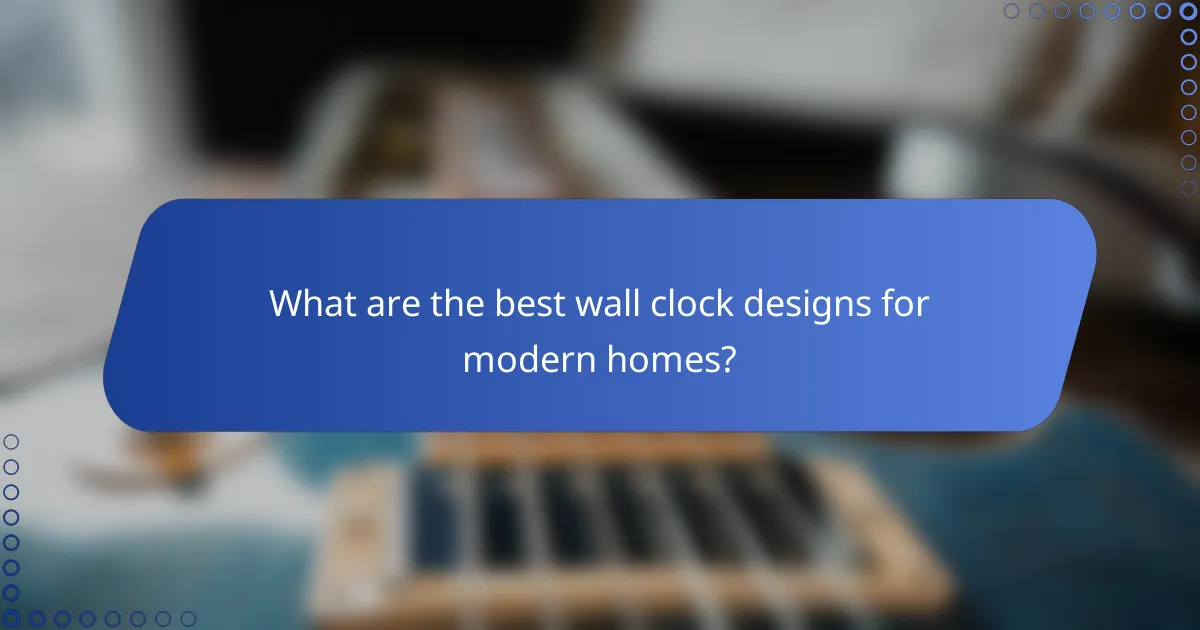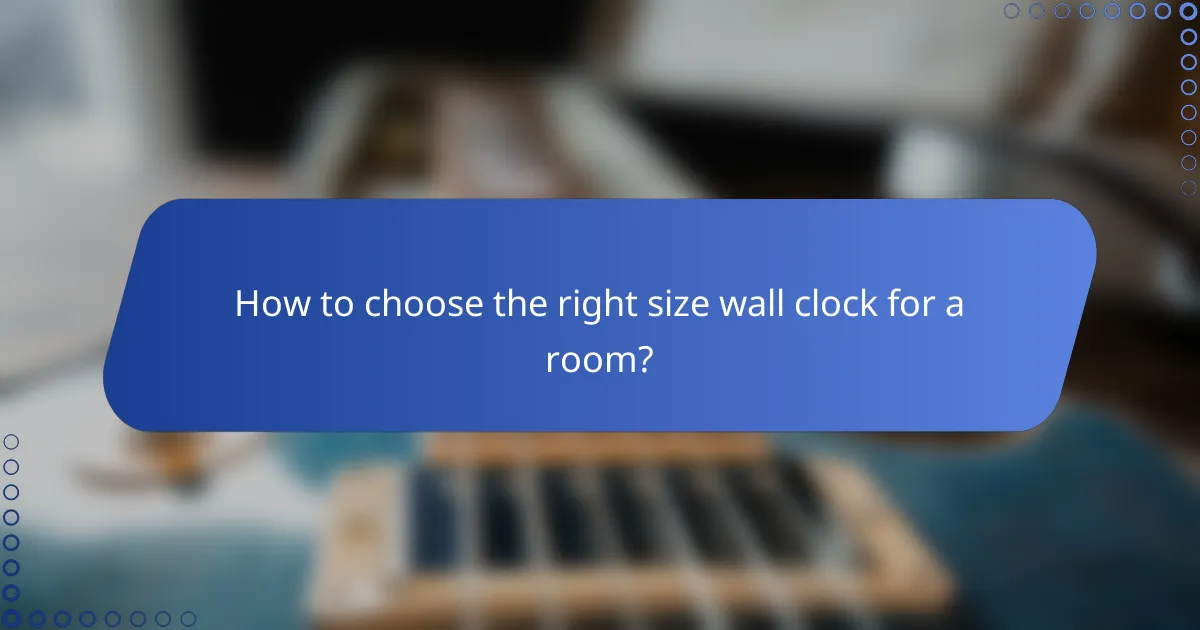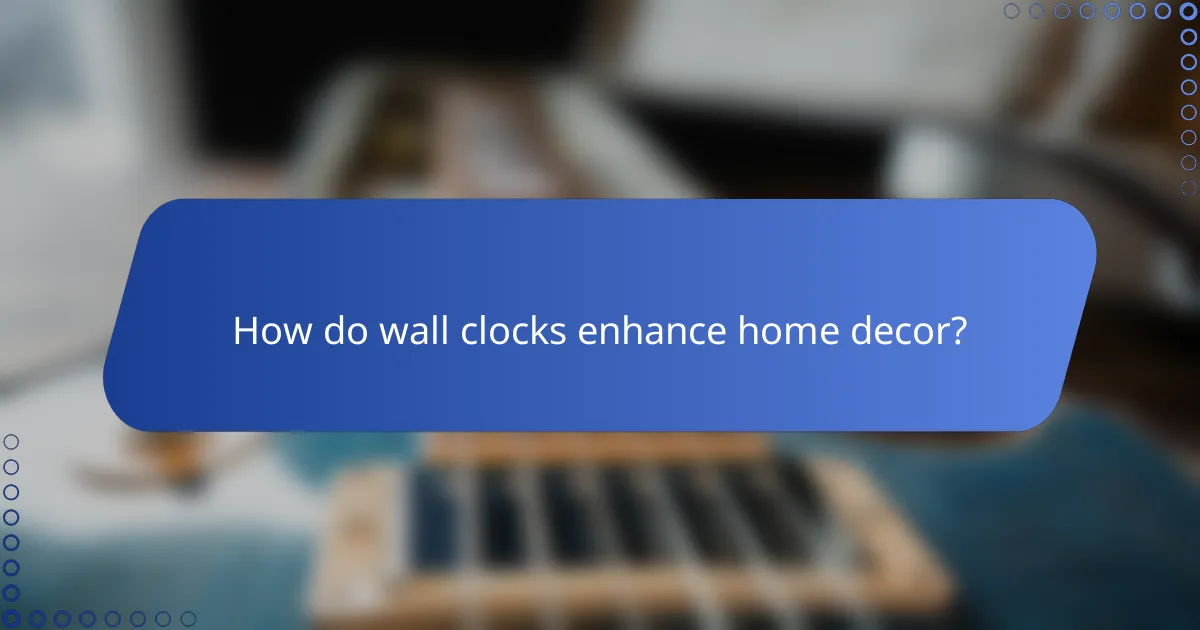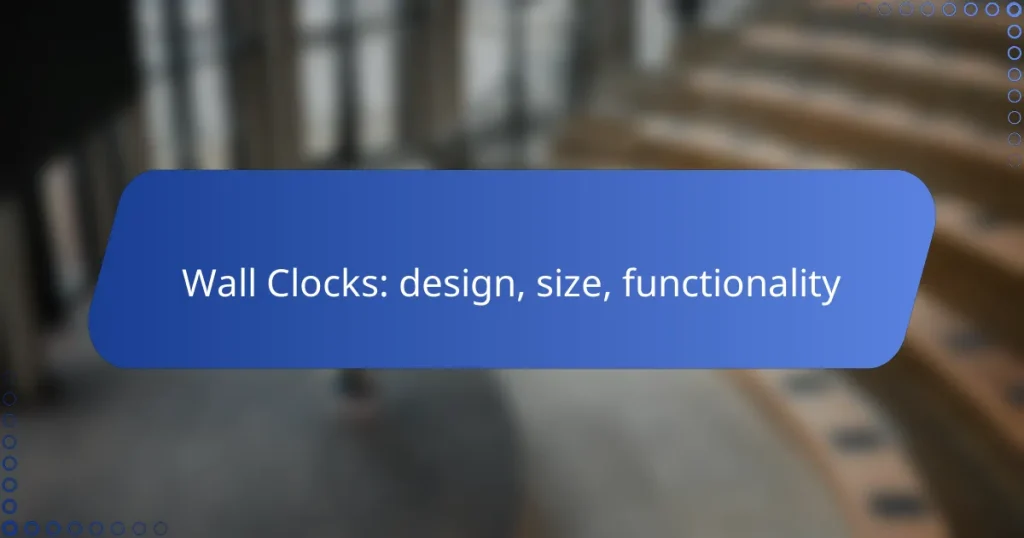Wall clocks are essential decorative elements that blend style with practicality in any home. With a variety of designs ranging from minimalist to vintage and smart options, these timepieces not only serve their primary function of keeping time but also enhance the aesthetic of a room. Selecting the appropriate size and features is crucial to ensure that the clock complements the space while meeting your specific needs.

What are the best wall clock designs for modern homes?
The best wall clock designs for modern homes combine aesthetics with functionality, enhancing the overall decor while serving their primary purpose of timekeeping. Popular styles include minimalist, vintage, and smart clocks, each offering unique features and visual appeal.
Minimalist wall clocks
Minimalist wall clocks focus on simplicity and clean lines, often featuring neutral colors and unobtrusive designs. These clocks typically have a sleek face with few or no embellishments, making them ideal for contemporary spaces.
When choosing a minimalist clock, consider options with silent movements to maintain a tranquil environment. Look for sizes that fit well within your wall space, generally ranging from 30 to 60 centimeters in diameter.
Vintage wall clocks
Vintage wall clocks evoke nostalgia with designs reminiscent of past eras, often featuring ornate details, Roman numerals, and distressed finishes. These clocks can serve as statement pieces, adding character to traditional or eclectic interiors.
When selecting a vintage clock, consider the material and craftsmanship. Wood, metal, and ceramic are common materials, and sizes can vary widely, from small mantel clocks to larger wall-mounted versions. Ensure the clock mechanism is reliable for accurate timekeeping.
Smart wall clocks
Smart wall clocks integrate technology with traditional timekeeping, offering features like digital displays, connectivity to smart home systems, and customizable alarms. These clocks can display weather updates, calendar events, and even reminders, making them practical for busy lifestyles.
When choosing a smart clock, look for compatibility with your existing smart home devices. Popular options range from compact models to larger screens, typically priced between $50 and $200. Ensure the clock has a user-friendly interface for easy navigation and setup.

How to choose the right size wall clock for a room?
Choosing the right size wall clock for a room involves considering the dimensions of the space and the visual impact you want to achieve. A clock that is too small may get lost on the wall, while one that is too large can overwhelm the area.
Small clocks for compact spaces
Small wall clocks, typically ranging from 20 to 30 centimeters in diameter, are ideal for compact spaces such as kitchens, bathrooms, or small offices. They can fit well above furniture or in corners without dominating the room.
When selecting a small clock, consider designs that are simple and easy to read. Clocks with minimalistic features or bold numerals can enhance visibility without taking up too much visual space.
Large clocks for open areas
Large wall clocks, often measuring over 60 centimeters in diameter, are perfect for open areas like living rooms or entryways. They serve as statement pieces and can draw attention, making the space feel more cohesive.
When choosing a large clock, ensure it complements the room’s decor and scale. A clock with intricate designs or bold colors can enhance the aesthetic, but be mindful of the overall balance in the room to avoid clutter.

What functionalities should I consider in wall clocks?
When selecting a wall clock, consider its display type, additional features, and how well it meets your specific needs. The right functionalities can enhance usability, making it easier to tell time and integrate into your daily routine.
Analog vs digital displays
Analog clocks feature traditional hour and minute hands, offering a classic aesthetic that many find appealing. They often provide a more artistic design, making them suitable for decorative purposes in homes and offices.
Digital clocks, on the other hand, display time in numerical format, which can be easier to read at a glance. They often include additional features such as backlighting and can be more functional for those who prefer precise timekeeping.
Additional features like alarms
Many wall clocks come with extra functionalities such as alarms, which can be useful for reminders or waking up. Clocks with multiple alarm settings allow for flexibility, accommodating different schedules.
Some models also include features like temperature displays, humidity sensors, or even Bluetooth connectivity for syncing with smart devices. When choosing, consider which features will genuinely enhance your daily life without adding unnecessary complexity.

What are popular wall clock brands in the UK?
In the UK, several brands are well-regarded for their wall clocks, combining style and functionality. Popular choices include Thomas Kent and Newgate Clocks, known for their unique designs and reliable timekeeping.
Thomas Kent
Thomas Kent is celebrated for its elegant and contemporary wall clocks that often feature a minimalist aesthetic. Their designs typically incorporate natural materials and soft colors, making them suitable for various interior styles.
When selecting a Thomas Kent clock, consider the size and finish that best complements your space. Their clocks range from small, decorative pieces to larger statement items, ensuring a fit for any room.
Newgate Clocks
Newgate Clocks is known for its bold and distinctive designs, often inspired by vintage styles. Their collection includes a variety of themes, from industrial to retro, appealing to diverse tastes.
When choosing a Newgate clock, pay attention to the clock’s functionality alongside its design. Many models feature quartz movements for accuracy, and some even include additional features like alarms or temperature displays, enhancing their practicality.

How do wall clocks enhance home decor?
Wall clocks enhance home decor by combining functionality with aesthetic appeal. They serve as both timekeeping devices and decorative elements, allowing homeowners to express their personal style while ensuring they stay punctual.
Accent pieces for style
Wall clocks can be striking accent pieces that contribute significantly to a room’s overall design. Available in various styles, from vintage to modern, they can complement or contrast with existing decor elements. For example, a sleek, minimalist clock can enhance a contemporary space, while a rustic wooden clock can add warmth to a traditional setting.
When selecting a wall clock as an accent piece, consider the size and color to ensure it harmonizes with other furnishings. A large clock can serve as a focal point, while smaller clocks can be grouped together for a gallery effect. Aim for a cohesive look by matching the clock’s finish with other metallic or wooden elements in the room.
Functional art for walls
Wall clocks are not just decorative; they are also functional art that serves a practical purpose. They help keep track of time while enhancing the visual appeal of a space. Many modern designs incorporate artistic elements, making them conversation starters and unique focal points.
When choosing a wall clock, consider its functionality alongside its design. Look for features such as easy-to-read numbers, silent mechanisms, or additional functionalities like temperature displays. Ensure that the clock fits well within the intended space, both in terms of size and style, to maximize its impact as a piece of functional art.

What materials are commonly used in wall clocks?
Wall clocks are typically made from materials like wood, metal, plastic, and glass. Each material offers distinct aesthetic and functional qualities that can influence the clock’s design and durability.
Wooden wall clocks
Wooden wall clocks are favored for their warm, natural appearance and can complement various interior styles. They are often crafted from hardwoods like oak, walnut, or maple, providing both durability and a classic look.
When choosing a wooden wall clock, consider the type of finish, as it can affect the clock’s maintenance and longevity. A well-finished wooden clock can last for years, while untreated wood may warp or degrade over time.
Metal wall clocks
Metal wall clocks are known for their modern and industrial aesthetic, often made from materials such as stainless steel, aluminum, or wrought iron. These clocks are typically more durable and resistant to wear compared to their wooden counterparts.
When selecting a metal wall clock, look for features like rust resistance and weight, as heavier clocks may require more robust mounting solutions. Metal clocks can also come in various finishes, including matte, polished, or brushed, allowing for customization to fit your decor.

How to maintain and care for wall clocks?
Maintaining and caring for wall clocks involves regular cleaning and timely battery replacements to ensure accurate timekeeping. Proper care can extend the lifespan of your clock and keep it functioning optimally.
Cleaning tips for wall clocks
To clean wall clocks, use a soft, dry cloth to gently wipe the surface and remove dust. For deeper cleaning, slightly dampen the cloth with water or a mild cleaner, avoiding any moisture in the clock’s mechanism.
Be cautious with glass-faced clocks; use a glass cleaner and a microfiber cloth to prevent scratches. Avoid harsh chemicals that could damage the finish or internal components.
Battery replacement guidelines
Most wall clocks require battery replacements every six to twelve months, depending on the type of movement and battery quality. Always check the battery type specified by the manufacturer to ensure compatibility.
When replacing the battery, turn the clock face down to prevent any damage. Remove the old battery and insert the new one, ensuring the correct polarity. After replacing, set the time and check for accuracy.

What are the trends in wall clock design for 2024?
In 2024, wall clock design trends emphasize minimalism, sustainability, and smart technology integration. Designers are focusing on clean lines, natural materials, and multifunctional features that enhance both aesthetics and utility.
Minimalist Designs
Minimalist wall clocks are characterized by their simplicity and elegance. They often feature neutral colors, unobtrusive shapes, and a lack of excessive ornamentation, making them suitable for various interior styles. This trend allows the clock to blend seamlessly into the decor while still serving its primary function.
When selecting a minimalist clock, consider options with silent mechanisms to enhance tranquility in your space. Brands like Muji and Nitori offer a range of minimalist clocks that prioritize both form and function.
Sustainable Materials
More consumers are seeking wall clocks made from sustainable materials, such as reclaimed wood, bamboo, or recycled metals. These eco-friendly options not only reduce environmental impact but also add a unique character to each piece. Choosing sustainable designs reflects a growing awareness of environmental issues.
Look for certifications or labels indicating sustainable sourcing when shopping. Brands like West Elm and Etsy often feature clocks that meet these eco-conscious criteria.
Smart Technology Integration
Smart wall clocks are becoming increasingly popular, offering features like Bluetooth connectivity, customizable displays, and integration with home automation systems. These clocks can sync with your smartphone or smart home devices, providing notifications and reminders directly on the clock face.
When considering a smart clock, evaluate compatibility with your existing devices and the ease of use of its features. Brands such as Lenovo and Amazon offer smart clock options that cater to various needs and preferences.


